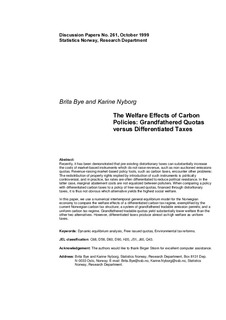| dc.contributor.author | Bye, Brita | |
| dc.contributor.author | Nyborg, Karine | |
| dc.date.accessioned | 2012-02-02T18:40:48Z | |
| dc.date.available | 2012-02-02T18:40:48Z | |
| dc.date.issued | 1999 | |
| dc.identifier.issn | 1892-753x | |
| dc.identifier.uri | http://hdl.handle.net/11250/180935 | |
| dc.description.abstract | Recently, it has been demonstrated that pre-existing distortionary taxes can substantially increase the costs of market-based instruments which do not raise revenue, such as non-auctioned emissions quotas. Revenue-raising market-based policy tools, such as carbon taxes, encounter other problems: The redistribution of property rights implied by introduction of such instruments is politically controversial, and in practice, tax rates are often differentiated to reduce political resistance. In the latter case, marginal abatement costs are not equalized between polluters. When comparing a policy with differentiated carbon taxes to a policy of free-issued quotas, financed through distortionary taxes, it is thus not obvious which alternative yields the highest social welfare. In this paper, we use a numerical intertemporal general equilibrium model for the Norwegian economy to compare the welfare effects of a differentiated carbon tax regime, exemplified by the current Norwegian carbon tax structure; a system of grandfathered tradable emission permits; and a uniform carbon tax regime. Grandfathered tradable quotas yield substantially lower welfare than the other two alternatives. However, differentiated taxes produce almost as high welfare as uniform taxes.
Keywords: Dynamic equilibrium analysis, Free issued quotas, Environmental tax reforms. | no_NO |
| dc.language.iso | eng | no_NO |
| dc.publisher | Statistics Norway, Research Department | no_NO |
| dc.relation.ispartofseries | Discussion Papers;No. 261 | |
| dc.subject | Environmental tax | no_NO |
| dc.subject | Carbon policy | no_NO |
| dc.subject | Welfare effects | no_NO |
| dc.subject | Dynamic equilibrium analysis | no_NO |
| dc.subject | General equilibrium model | no_NO |
| dc.subject | JEL classification: C68 | no_NO |
| dc.subject | JEL classification: D58 | no_NO |
| dc.subject | JEL classification: D60 | no_NO |
| dc.subject | JEL classification: D90 | no_NO |
| dc.subject | JEL classification: H20 | no_NO |
| dc.subject | JEL classification: J51 | no_NO |
| dc.subject | JEL classification: J60 | no_NO |
| dc.subject | JEL classification: Q43 | no_NO |
| dc.title | The welfare effects of carbon policies: grandfathered quotas versus differentiated taxes | no_NO |
| dc.type | Working paper | no_NO |
| dc.subject.nsi | VDP::Social science: 200::Economics: 210::Economics: 212 | no_NO |
| dc.source.pagenumber | 27 s. | no_NO |
